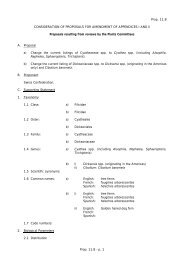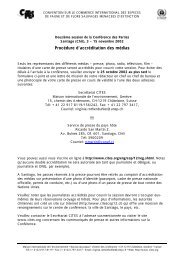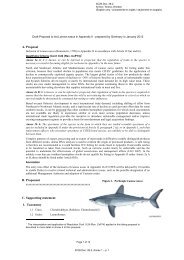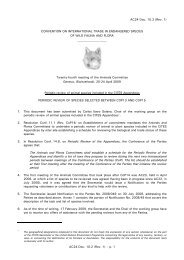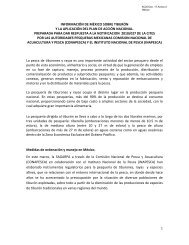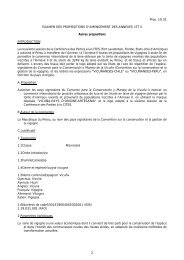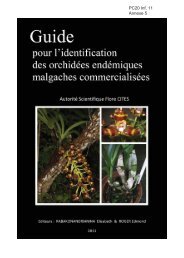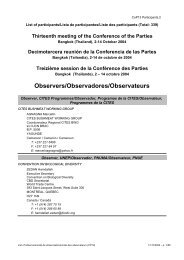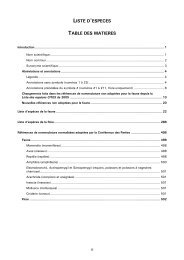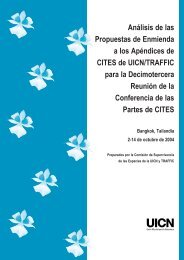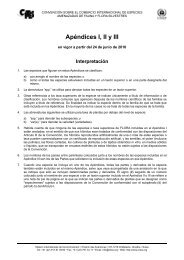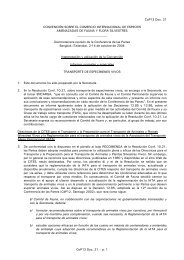English CoP16 Prop. 33 CONVENTION ON - Cites
English CoP16 Prop. 33 CONVENTION ON - Cites
English CoP16 Prop. 33 CONVENTION ON - Cites
Create successful ePaper yourself
Turn your PDF publications into a flip-book with our unique Google optimized e-Paper software.
Original language: <strong>English</strong> <strong>CoP16</strong> <strong>Prop</strong>. <strong>33</strong><br />
A. <strong>Prop</strong>osal<br />
<strong>C<strong>ON</strong>VENTI<strong>ON</strong></strong> <strong>ON</strong> INTERNATI<strong>ON</strong>AL TRADE IN ENDANGERED SPECIES<br />
OF WILD FAUNA AND FLORA<br />
____________________<br />
Sixteenth meeting of the Conference of the Parties<br />
Bangkok (Thailand), 3-14 March 2013<br />
C<strong>ON</strong>SIDERATI<strong>ON</strong> OF PROPOSALS FOR AMENDMENT OF APPENDICES I AND II<br />
Transfer of the species Cuora galbinifrons from Appendix II to Appendix I, in accordance with Res. Conf.<br />
9.24 (Rev.CoP15), under criteria C i) and C ii) (patterns of exploitation, intrinsic vulnerability) of Annex 1.<br />
B. <strong>Prop</strong>onent<br />
Viet Nam *<br />
C. Supporting statement<br />
1. Taxonomy<br />
1.1 Class: Reptilia<br />
1.2 Order: Testudines<br />
1.3 Family: Geoemydidae<br />
1.4 Genus, species or subspecies,<br />
including author and year: Cuora galbinifrons Bourret, 1939<br />
Specifically including its subspecies<br />
Cuora galbinifrons galbinifrons Bourret, 1939<br />
Cuora galbinifrons bourreti Obst & Reimann, 1994<br />
Cuora galbinifrons picturata Lehr, Fritz & Obst, 1998<br />
1.5 Scientific synonyms: Cyclemys flavomarginata hainanensis Li, 1958 =<br />
Cuora galbinifrons galbinifrons<br />
Cuora galbinifrons serrata Iverson & McCord, 1992 – documented by<br />
Parham et al (2001) to be a hybrid between Cuora galbinifrons and<br />
Cuora mouhotii.<br />
Note: the species galbinifrons has on occasion been placed in the genus Cistoclemmys. The forms<br />
bourreti and picturata have been proposed to warrant recognition as full species (Stuart & Parham,<br />
2004), and species rank has been recognized by some, but not all, subsequent authors. This<br />
proposal follows the Standard Reference for Turtles (Fritz & Havas, 2007), which recognizes bourreti<br />
and picturata as subspecies of Cuora galbinifrons. Fritz & Havas (2007) provide extensive<br />
documentation of genus and species name and rank permutation synonyms used in the literature.<br />
* The geographical designations employed in this document do not imply the expression of any opinion whatsoever on the part of the<br />
CITES Secretariat or the United Nations Environment Programme concerning the legal status of any country, territory, or area, or<br />
concerning the delimitation of its frontiers or boundaries. The responsibility for the contents of the document rests exclusively with its<br />
author.<br />
<strong>CoP16</strong> <strong>Prop</strong>. <strong>33</strong> – p. 1
1.6 Common names: <strong>English</strong>: Indochinese Box Turtle; Flowerback Box Turtle; Bourret’s Box<br />
Turtle [bourreti]; Southern Vietnam Box Turtle [picturata]<br />
French: Tortue-boîte à front jaune<br />
Spanish: Tortuga caja de Indochina<br />
1.7 Code numbers: ITIS TSN: 551910<br />
2. Overview<br />
Cuora galbinifrons is a medium-sized turtle that inhabits upland, moist, closed-canopy forest in PR China,<br />
Lao PDR, Viet Nam and possibly Cambodia. Three subspecies are recognized, which are treated as full<br />
species by some taxonomists. Animals take about 12 to 15 years to mature, and females produce a single<br />
clutch of 1-3 eggs per year; egg and hatchling mortality rates are high, and recruitment is slow. The<br />
species is challenging to establish and reproduce in captivity, and the great majority of trade concerns<br />
animals collected from the wild. Available field survey information shows that the species is at best<br />
uncommon, and that populations have been severely depleted in recent decades. Most records derive<br />
from observations of collected animals; field encounters are rare even during dedicated surveys.<br />
The primary threat to Cuora galbinifrons is collection for trade. The species is in high demand in the<br />
international pet trade and the Asian consumption trade. Collection efforts include both casual encounters<br />
when collecting other forest products, and targeted searches for turtles involving trained dogs and/or<br />
burning undergrowth to drive and expose turtles. Turtles encountered are collected, regardless of legal<br />
protection status or location inside protected areas. Collected turtles are traded, mostly illegally, through a<br />
network of local middlemen before being exported or consumed locally. Documented market trade<br />
volumes may be several orders of magnitude greater than total reported legal trade volumes. Habitat loss<br />
and degradation is a secondary threat to the species.<br />
Cuora galbinifrons is legally protected from exploitation (or under evaluation for inclusion under strict<br />
protective legislation) in all range countries, but enforcement may be insufficient. To address illegal trade in<br />
this species, its protection status in national laws and under CITES must be increased. This species is<br />
proposed for transfer to Appendix I of CITES, as it meets Criterion C i) of Annex I of<br />
Res.Conf.9.24(Rev.CoP15), by having been documented to have declined severely across its range as a<br />
result of collection for trade (see section 4.4), and meets criterion C ii) as the pattern of local, casual<br />
exploitation combined with unsustainable targeted collection for trade (see sections 5 and 6.4) will likely<br />
continue unless stronger measures are implemented, and the slow recruitment and late maturity make the<br />
species intrinsically vulnerable to exploitation (see sections. 3.3 and 6.5).<br />
3. Species characteristics<br />
3.1 Distribution<br />
Cuora galbinifrons inhabits P.R. China, Lao P.D.R., and Viet Nam. The species has been suggested,<br />
but not confirmed, to range into extreme northeastern Cambodia.<br />
Cuora galbinifrons galbinifrons is confirmed to occur in Hainan and Guangxi in PR China, in northern<br />
Lao PDR, and in northern Viet Nam at least as far south as Nghe An province (Iverson, 1992; Stuart<br />
et al., 2002; Stuart & Parham, 2004; Stuart & Platt, 2004; Fritz & Havas, 2007; Shi et al., 2008a)<br />
Cuora galbinifrons bourreti is known from central Viet Nam, as well as from adjoining Savannakhet<br />
Province in Lao PDR (Stuart et al., 2011).<br />
Cuora galbinifrons picturata is apparently restricted to the eastern slopes of the Langbian Plateau,<br />
being known only from Khanh Hoa and Phu Yen provinces of southern Viet Nam (Ly et al., 2011).<br />
3.2 Habitat<br />
Cuora galbinifrons inhabits upland, moist, closed-canopy forest, usually between 300 and 1700 m<br />
altitude. The species is predominantly terrestrial and is not specifically associated with forest streams,<br />
though animals can swim relatively well and can be seen, at least in captivity, wallowing in shallow<br />
water or swampy areas. It is considered a cool forest turtle, with temperatures exceeding 28ºC often<br />
resulting in stress and poor incubation success in captive animals (Stuart & Platt, 2004; Ly et al.,<br />
2011; Wang et al., 2011; T.McCormack, in litt. to VN MA, 29 Sept 2012).<br />
<strong>CoP16</strong> <strong>Prop</strong>. <strong>33</strong> – p. 2
3.3 Biological characteristics<br />
Extremely little is known of the biology of Cuora galbinifrons in the wild; most observations on diet,<br />
growth and reproduction derive from animals maintained in captivity, either within or close to the<br />
species’ natural range, or in artificially manipulated captive conditions such as terrariums.<br />
The species appears to be omnivorous; its recorded diet includes earthworms, carrion and fruit.<br />
Research on movement patterns, microhabitat use and other aspects of natural history have been<br />
carried out at the population of Diao Luo Shan in Hainan, China (Wang et al., 2011).<br />
Slow growth (10-15 years) to maturity is combined with low fecundity; in captivity a single clutch of 1-<br />
3 eggs is seen each year in Cuc Phuong National Park where a small group is maintained<br />
(McCormack, in litt. To VN MA, 29 Sept 2012). Similar clutch sizes of 1 to 3 eggs have been reported<br />
from long-term captive animals kept in Europe and North America (Bruin, 1994; Fiebig & Lehr, 2000;<br />
Struijk, 2010).<br />
3.4 Morphological characteristics<br />
Cuora galbinifrons is a medium-sized turtle, reaching up to 19 cm carapace length at a weight of<br />
about 800 to 1200 grams. Males and females reach about the same size. Hatchlings measure about<br />
45-50 mm and weigh 15-24 grams. The carapace (upper shell) is smooth, rounded and high-domed.<br />
The plastron (lower shell) has a very distinct hinge which allows the front and rear parts of the<br />
plastron to be raised up against the carapace, closing both front and back shell openings completely.<br />
All three subspecies have a very distinct yellow or orange area on each side of the carapace,<br />
contrasting strongly with the remainder of the shell which is mainly rich dark brown. The three<br />
subspecies are differentiated by differences in colouration and shell shape:<br />
In Cuora galbinifrons galbinifrons, the shell is relatively long and oval when viewed from above. The<br />
middle of the carapace shows a broad brown band with black edges; the brown band splits on the<br />
first vertebral scute, and only two narrow extensions reach forward to the carapace margin, enclosing<br />
a yellow area above the neck. A fine yellow, black-edged vertebral line is normally present. The lower<br />
2/3 of each costal scute area is uniform yellow (sometimes with small black markings), creating a<br />
distinct large yellow ‘window’. Most of the marginals are dark brown or black, including upper area<br />
and underside. The plastron is uniform black, or in some older animals is mostly black with some<br />
irregular areas of less dense pigmentation appearing yellowish in the midline and/or along scute<br />
seams. The head colouration variable, and usually shows areas of bright yellow, orange and red and<br />
fine black speckling. The front limbs are generally dark, with some of the large scales being bright<br />
yellow or orange.<br />
Cuora galbinifrons bourreti also has a relatively long and oval shell. The carapace shows a fairly<br />
irregular pattern of black, brown and yellow: A broad brown band with black edges runs over the<br />
middle of the carapace, not always clearly distinct from the rest of the carapace; the brown band<br />
extends forward to reach a broad area of the carapace margin above the neck. A fine pale vertebral<br />
line is often vague, interrupted, or completely absent. A vague cloudy dark band extends across much<br />
of the middle of the costal scutes, leaving the remaining costal scute areas bright yellow both above<br />
and below this irregular band. The effect can create two sets of yellow areas, one along the upper<br />
costal scutes, the other in the lower areas of the costals. The marginal scutes are generally dark, at<br />
least their upper areas always has dark pigmentation. The plastron is yellow with a large black cloudy<br />
spot on each scute; these spots can be large enough to connect to each other, forming a black<br />
horseshoe-shaped mark or mostly black band around the plastron. The underside of the marginal<br />
scutes can vary from yellowish with small black markings to mostly black with some yellow along the<br />
margins. The head is bright yellow or orange to brown with some dark spotting, but never deep red.<br />
The soft parts of the legs and tail are generally grey with yellow.<br />
Cuora galbinifrons picturata has a characteristic very short, steeply domed, high shell, that appears<br />
almost round when seen from above. The carapace appears pale yellow with dark marks, which are<br />
rather regular and sharply defined: A broad brown band with black edges runs over the middle of the<br />
carapace; this brown band splits on the first vertebral scute, and only two narrow extensions reach<br />
forward to the carapace margin, enclosing a yellow area above the neck. A fine yellow, black-edged<br />
vertebral line is normally present. The middle part of the costal scutes has a yellow ground colour, but<br />
as animals grow and age this usually shows some brown or black markings, obscuring the distinct<br />
clear yellow area shown by young animals. A dark band extends across much of the lower part of the<br />
costal scutes, and often extends onto the upper part of the marginal scutes, particularly on the<br />
<strong>CoP16</strong> <strong>Prop</strong>. <strong>33</strong> – p. 3
posterior part of the shell. The marginal scutes are generally uniform yellow in the region over the<br />
front legs, or with a single distinct black spot, with increasing dark markings in the bridge region, and<br />
with extensive brown or black markings over the hind legs and tail region. The plastron is yellow,<br />
usually with a small to large black blotch at the outer edge of each scute. The underside of the<br />
marginal scutes is generally uniform yellowish. The head is bright yellow, often with fine grey or black<br />
spots, streaks or networking, but no red on the head or throat. The soft parts of the legs and tail are<br />
generally yellow, the large scales on the front limbs are marbled grey and yellow.<br />
Detailed information to differentiate the three subspecies was provided by Tabaka (2002, available<br />
online).<br />
3.5 Role of the species in its ecosystem<br />
The role of Cuora galbinifrons in its native upland forest ecosystems is unknown; by analogy with<br />
other forest turtles, the species likely plays a modest ecological role in the dispersal of plant seeds<br />
and mushroom spores, and as a consumer of invertebrates.<br />
4. Status and trends<br />
4.1 Habitat trends<br />
Forest cover in Vietnam fell from 14.3 million ha (43% land area) in 1943 to 9.5 million ha (29%) in<br />
1973, and since then the area under forest cover has appeared relatively stable at assessments in<br />
1979-81 and 1995 (FAO, 1997; FSIV, 2009). Recent increases in forest cover since the early<br />
2000 have largely been due to the 1998-2010 goal to reforest 5 million ha under national decision No.<br />
661/QD-TTg (661 Programme: Decision No. 661/QD-TTg dated 29 July 1998 by the Prime Minister<br />
on objectives, tasks, policy and Organisation for implementation the 5 million hectares afforestation<br />
national programme) (ICEM 2003). Reforestation has mostly been monoculture, while the primary<br />
forests on which this species depends continues to be lost or degraded.<br />
4.2 Population size<br />
No absolute population size numbers or estimates are available, and only anecdotal relative<br />
population density data. All recent indications are that the species requires extensive search effort to<br />
encounter.<br />
During field surveys in Lao PDR in 1993-1999, encounter rates were at the order of one turtle per<br />
three months in the field for a herpetologist, and one Cuora galbinifrons per day when working with a<br />
trained turtle hunting dog in prime turtle habitat (Stuart & Timmins, 2000).<br />
During a field survey in May 2012 in Deo Ca – Hon Nua Special Use Forest (a traditional collecting<br />
area in Phu Yen province, Viet Nam), a team of five dogs (four local hunting dogs and one trained<br />
survey dog) found only a single Cuora galbinifrons picturata and two Cuora mouhotii during a week of<br />
searching in which dogs were actively used over 21.7km of transects (T.McCormack, in litt to VN MA,<br />
29 Sept 2012). Assuming that a team of dogs works a strip of a minimum width of 100 m, and finds<br />
half of all exposed and hidden turtles, this calculates to an estimated density of less than one Cuora<br />
galbinifrons per square km.<br />
4.3 Population structure<br />
No population structure data are available. No distinct sex bias has been observed during field or<br />
trade surveys. All age classes except hatchlings are seen in trade; juveniles are normally kept at the<br />
village level as traders prefer not to buy very small individuals.<br />
4.4 Population trends<br />
A great deal of survey work has been undertaken in Viet Nam between 2009 – 2012 focused on<br />
determining the range and priority habitat for Cuora galbinifrons, with a focus on Cuora g. bourreti<br />
and Cuora g. picturata. Anecdotal information from interviews throughout the range has found that<br />
historic quantities of the species available for collection in the forest have been greatly reduced, with<br />
many hunters stating that while the species was common 7-15 years ago, it is now increasingly<br />
difficult to find.<br />
<strong>CoP16</strong> <strong>Prop</strong>. <strong>33</strong> – p. 4
Similarly during surveys in 2006 in and around Song Thanh Nature Reserve, Quang Nam province<br />
local hunters at that time claimed that numbers of Cuora g. bourreti had already been seriously<br />
depleted, from being able to catch 20 animals a day in the in the mid 1990’s to only a few animals a<br />
week. However the increasing economic value of the species to an average of US$15.00 per kg is an<br />
increase from 2006, when surveys found an average value of US$9.00 around Song Thanh Nature<br />
Reserve, Quang Nam province.<br />
During a survey around Deo Ca – Hon Nua Special Use Forest in May 2012, local hunters claimed<br />
they still caught 50 individuals of the species annually (during a six month hunting season) using<br />
large packs of hunting dogs, even when a pack of five dogs found just a single Cuora galbinifrons<br />
picturata and two C. mouhotii during a week’s hunting, when 21.7 km of trails and transects were<br />
searched (T.McCormack, in litt to VN MA, 29 Sept 2012). Given the low fecundity and slow growth of<br />
the species, this level of collection is likely unsustainable and decimating populations of Cuora g.<br />
picturata at this location.<br />
Similar reports of reductions in wild populations, and corresponding increases in wholesale prices<br />
paid, have been documented during interviews throughout the species range in Viet Nam<br />
(T.McCormack, in litt to VN MA, 29 Sept 2012).<br />
4.5 Geographic trends<br />
5. Threats<br />
All available information indicates that the species is intensively collected throughout its range in PR<br />
China, Lao PDR and Viet Nam.<br />
The primary threat to Cuora galbinifrons is collection for trade. The species is in high demand in the<br />
international pet trade and the Asian consumption trade. Collection efforts include both targeted searches<br />
for turtles involving trained dogs, or occasionally pitfall traps, as well as capitalizing on casual turtle<br />
encounters when collecting other forest products. Turtles, of any species, are collected whenever and<br />
wherever encountered in the region, regardless of legal protection status or location inside protected<br />
areas. Collected turtles are traded, mostly illegally, through a network of local middlemen before being<br />
exported or consumed locally. Increasing economic value has ensured that hunting pressure is sustained<br />
despite the increasing rarity of the species (Hendrie, 2000; Stuart & Timmins, 2000; McCormack et al.,<br />
2010).<br />
Habitat loss and degradation are considered a significant but more localized threat to the species.<br />
Cuora galbinifrons was assessed as Critically Endangered for the IUCN Red List of Threatened Species in<br />
2000, based on an assessment of prevailing trade impacts at that time. It is currently in the process of reassessment,<br />
and preliminary findings indicate that the species will be retained as Critically Endangered<br />
(TTWG, 2011; Horne et al., 2012). Cuora galbinifrons is listed as Endangered in the Viet Nam Red data<br />
Book, and also as Endangered in the China Red Data Book of Endangered Animals (Zhao, 1998).<br />
6. Utilization and trade<br />
6.1 National utilization<br />
Historically Cuora galbinifrons have been consumed locally for food as part of a subsistence diet,<br />
however in the last decade consumption has largely ceased with most animals now sold into the<br />
trade due to the high economic incentive. Juvenile animals are often kept at the village level in<br />
attempts to raise them to sell on into the trade (often unsuccessful, with animals dying).<br />
The species does not have specific local medicinal uses as is seen in other species, e.g.<br />
Cuora trifasciata or Mauremys annamensis but bones are often sold to traders for production of bone<br />
glue. In some areas turtles of all species are consumed as broad “health invigorators”.<br />
6.2 Legal trade<br />
The UNEP-WCMC CITES trade database recorded a total of 2529 net exported animals or<br />
specimens of Cuora galbinifrons during the period 2000-2011 (Gross exports amounted to<br />
2569 animals or specimens). The table below documents declared net exports for the countries which<br />
<strong>CoP16</strong> <strong>Prop</strong>. <strong>33</strong> – p. 5
exported more than 10 animals in total during this period (another 19 animals or specimens were<br />
exported from a total of 8 countries).<br />
Taxon Term Country 2000 2001 2002 2003 2004 2005 2006 2007 2008 2009 2010 2011 Total<br />
Cuora<br />
galbinifrons live CN 0 0 24 0 6 0 0 5 0 0 3 0 38<br />
Cuora<br />
galbinifrons live HK 287 62 281 174 40 0 0 0 0 12 11 0 867<br />
Cuora<br />
galbinifrons<br />
speci<br />
mens HK 0 0 0 14 0 0 0 0 0 0 0 0 14<br />
Cuora<br />
galbinifrons live JE 0 0 0 0 0 1 0 0 8 3 0 0 12<br />
Cuora<br />
galbinifrons live LA 0 0 0 0 0 0 1500 0 0 0 0 0 1500<br />
Cuora<br />
galbinifrons live LB 0 0 0 0 0 13 0 0 0 0 0 0 13<br />
Cuora<br />
galbinifrons live VN <strong>33</strong> 16 0 0 0 0 0 0 0 0 0 0 49<br />
Cuora<br />
galbinifrons<br />
speci<br />
mens VN 0 0 0 14 2 0 0 0 0 1 0 0 17<br />
6.3 Parts and derivatives in trade<br />
320 78 305 202 48 14 1500 5 8 16 14 0<br />
All turtle shells are bought in Vietnam by traders to make into a generic bone glue, plastrons are<br />
normally preferred. In some areas shell fragments are discarded. In many areas shells considered<br />
beautiful are kept as household decorations, this is often seen with Cuora galbinifrons and<br />
Manouria impressa.<br />
Some shells or shell fragments are traded internationally: Chen et al. (2009) recorded that<br />
Cuora galbinifrons were rare but present among imported turtle shells for Chinese traditional<br />
medicine in Taiwan Province of China.<br />
6.4 Illegal trade<br />
Visible trade in Cuora galbininfrons at Hanoi’s principal wildlife market, Don Xuan, stopped by about<br />
2006 due to better market enforcement. Prior to this, dozens of Cuora galbinifrons were regularly<br />
available each week, these were often juvenile animals and intended for the pet market, not food.<br />
It is believed that most Cuora galbinifrons traded in Viet Nam are exported to Chinese markets. The<br />
species was present in nearly every reported market survey that looked at turtle trade in China and<br />
Hong Kong since recording began in 1993. All these animals appeared wild caught and most were<br />
offered in the food markets (Lau et al., 1995; Artner and Hofer, 2001; Wang et al., 2005; Gong et al.,<br />
2005, 2006, 2009; Cheung & Dudgeon, 2006; Wu, 2007). Cheung and Dudgeon recorded over<br />
15,000 Cuora galbinifrons traded in Hong Kong markets alone during the period 2000-2003;<br />
comparing this to the total of 905 C. galbinifrons that were recorded in the CITES trade database as<br />
exported during this same period worldwide (see 6.2, above) hints at the scale of illegal and<br />
unrecorded trade. The volume of C. galbinifrons in visible trade continues to be highly significant in<br />
recent years; market surveys by the Wildlife Conservation Society during 2008-2011 in Guangzhou,<br />
China, documented 1826 animals observed in food markets, and another 1944 animals recorded in<br />
the local pet trade (Roberton, in litt to VN CITES MA).<br />
6.5 Actual or potential trade impacts<br />
Long-lived, late-maturing species with limited annual reproductive output and high juvenile mortality,<br />
as exemplified by Cuora galbinifrons, have proven to be highly susceptible to overexploitation,<br />
particularly of adult animals (Doroff & Keith, 1990; Gibbons, 1990; Congdon et al., 1993; O’Brien et<br />
al., 2003). The population trend data in section 4.4 strongly suggests that Cuora galbinifrons has<br />
been subject to unsustainable collection for the past 15-20 years and this has resulted in the<br />
depletion if not collapse of each populations that has been surveyed. Of particular significance is that<br />
commercial turtle farms in East Asia create a specific demand for animals collected from the wild,<br />
<strong>CoP16</strong> <strong>Prop</strong>. <strong>33</strong> – p. 6
eing considered the primary purchasers of wild-collected turtles and driving the collection of the last<br />
remaining wild animals through increased trade prices (Shi et al., 2007).<br />
In a separate, innovative analysis of risk posed by international trade, Cuora galbinifrons emerged<br />
with a relatively high score (1.5 out of a maximum of 2.0) of endangerment from trade (Zhou & Jiang,<br />
2008).<br />
7. Legal instruments<br />
7.1 National<br />
P.R. China: The People’s Republic of China Wild Animals Protection Law (1989) forms the national<br />
cornerstone of protection of wildlife species. The Wild Animals Protection Law also covers important<br />
economic and scientific species; Cuora galbinifrons is included in the list of National Protected<br />
Terrestrial Wild Animals that are Beneficial, or with Important Economic and Scientific Research<br />
Value, which was published by the State Forestry Administration in 2000. For terrestrial species, the<br />
State Forestry Administration is responsible for the administering and enforcing of this law, while the<br />
Fisheries Ministry is responsible for the aquatic species. The collecting of state major protected<br />
species is only allowed for scientific research, captive-breeding, exhibition and other special reasons.<br />
The transport of state major protected species across county boundary needs the permission from<br />
the provincial Forestry or Fisheries Department. The import and export of these state major protected<br />
species and CITES-listed species need the permission from the Forestry or Fisheries bureau in the<br />
central government and a certificate issued by the Endangered Species Import and Export<br />
Management Office of the People’s Republic of China (Shi & Lau, 2000; Endangered Species Import<br />
and Export Management Office of the People’s Republic of China, 2002a).<br />
Lao P.D.R.: Principles, regulations and measures for the protection and management of wildlife are<br />
governed by the Wildlife and Aquatic Species Law (No07/NA 24 December 2007); Cuora galbinifrons<br />
is listed under Prohibited Category I, the highest the protective category, banning hunting and<br />
collection year-round.<br />
Viet Nam: Cuora galbinfrons is presently not protected under Vietnam’s principal wildlife protection<br />
law Decree 32/2006/ND-CP, but a proposal to include the Cuora galbinifrons group under this law is<br />
currently under consideration. The Law on Forest Protection and Development, last updated in May<br />
2011, states under article 41 that the hunting, catching, trapping and caging of forest animals must be<br />
permitted by competent State bodies and comply with law provisions on wildlife conservation.<br />
Therefore, hunting permits are required under this law, and the regulatory framework to implement a<br />
system of monitored hunting permits is presently being compiled. Wildlife does need permits to be<br />
transported nationally; such transport permits can be issued by provincial Forest Protection<br />
Department offices. A veterinary health certificate may also be required.<br />
Operations engaged in farming of wildlife species can be registered at the provincial level for species<br />
that are not registered under Decree 32, the principal wildlife protection law. Decree 82/2006/ND-CP<br />
provides guidance on farm laws and template documents to complete registration. As<br />
Cuora galbinifrons is not IB or IIB under decree 32, it can be registered for farming at present. Wildlife<br />
to be registered has to be collected under permit, bought from an existing “breeding farm” or bought<br />
from a Forest Protection Department (FPD) sale.<br />
Cambodia: Cuora galbinifrons has not yet been confirmed to occur in Cambodia, and is currently not<br />
specifically listed in Cambodian protective wildlife legislation or regulations.<br />
7.2 International<br />
Cuora galbinifrons was included in CITES Appendix II at CoP 11 (<strong>Prop</strong>osal 36, Gigiri, Kenya, 2000),<br />
and was selected for the Review of Significant Trade (RST) at AC17; its progress through the<br />
RST process was detailed on pages 21-22 of document AC25 Doc. 19.<br />
The genus Cuora, including Cuora galbinifrons, is included in Annex B of EU Commission Regulation<br />
no. 709/2010 (amending EC Regulation <strong>33</strong>8/97), which requires that a corresponding import permit<br />
must be issued by the country of import before a shipment of the species can enter the European<br />
Union.<br />
<strong>CoP16</strong> <strong>Prop</strong>. <strong>33</strong> – p. 7
Health inspection certification is required by a number of countries before live animals, including<br />
turtles, may be imported.<br />
The recommended conditions for transport of live turtles by air are detailed in the IATA Live Animals<br />
Regulations; compulsory adherence to these Live Animal Regulations has been adopted by<br />
legislation in a number of countries, and is required by a number of international airlines.<br />
8. Species management<br />
8.1 Management measures<br />
Populations of Cuora galbinifrons are not known to be managed or manipulated in any part of its<br />
range. A conservation initiative to focus on Cuora g. bourreti through improved protected area<br />
management, community engagement and enforcement capacity building has been initiated at Song<br />
Thanh Nature Reserve, Quang Nam province in Central Viet Nam (McCormack et al., 2006).<br />
8.2 Population monitoring<br />
No population monitoring programs are known to be in place for Cuora galbinifrons anywhere in the<br />
species’ range.<br />
8.3 Control measures<br />
8.3.1 International<br />
Since its inclusion in CITES Appendix II, international shipments of Cuora galbinifrons are required to<br />
be accompanied by appropriate export permits, and subject to the customary checks by customs and<br />
wildlife authorities at the points of export and import.<br />
8.3.2 Domestic<br />
No control measures are in place beyond those described in section 7.1, national legislation and<br />
regulations.<br />
Wildlife authorities, customs and enforcement authorities of the range and trading countries have<br />
made great efforts to ensure that turtles traded within their jurisdiction are legal and regulated, as<br />
evidenced by extensive record of confiscations of illegally traded turtles in the countries of the region<br />
(AC25 Doc.19, Annex C. However, resources such as officers trained in wildlife identification and<br />
identification materials in local languages remain limited, and in many cases the judicial system does<br />
not give high priority to wildlife crimes.<br />
8.4 Captive breeding and artificial propagation<br />
The Turtle Conservation Centre at Cuc Phuong National Park has been breeding Cuora galbinifrons<br />
(subspecies bourreti and galbinifrons) with limited success; survival in eggs is low and long term<br />
survival of hatchlings is lower. Some early hatchlings are now (2012) nearing seven years of age.<br />
Low incubation temperatures, 25-28ºC, are an important factor for successful reproduction, as are<br />
cool, humid environmental conditions for juveniles and a high protein diet. Around<br />
30 Cuora galbinifrons of all three subspecies are maintained at the centre.<br />
Cuora galbinifrons is maintained in modest numbers in captivity by hobbyists in Asia, Europe, North<br />
America and elsewhere, and has been bred in captivity, but continues to be regarded as a difficult,<br />
sensitive species that is challenging (but not impossible) to establish and reproduce consistently in<br />
captivity (Buskirk, 1989; de Bruin, 1994; Fiebig & Lehr, 2000; Struijk, 2010). A European studbook<br />
exist for the species since the late 1990s, with over 150 registered animals maintained at institutions<br />
and private keepers in eight countries in 2009 (Struijk, 2010).<br />
Cuora galbinifrons was recorded among the stock kept at commercial turtle farms in China in the<br />
early 2000’s (Parham et al., 2001; Germany SA, 2003), but is understood not to breed successfully<br />
(i.e., production exceeding mortality) in commercial captive conditions and is no longer included in<br />
inventories of turtle farms in recent years (Endangered Species Import and Export Management<br />
Office of the People’s Republic of China, 2002b; Zhou et al., 2005, 2008; Shi et al., 2008b).<br />
<strong>CoP16</strong> <strong>Prop</strong>. <strong>33</strong> – p. 8
8.5 Habitat conservation<br />
Habitat conservation, in the form of National Parks, Special Conservation Areas, and other protected<br />
areas, is in place across much of the range of Cuora galbinifrons galbinifrons and C. g. bourreti, and<br />
several records of these turtles originate from inside protected areas (Stuart & Platt,<br />
2004; McCormack et al., 2006; Stuart et al., 2011; Wang et al., 2011). However, designation as<br />
protected area does not necessarily lead to effective restrictions on the collection of turtles and other<br />
‘forest products’, and is insufficient by itself to safeguard viable populations of the species in its<br />
natural habitat. The picturata population has not been confirmed to occur in protected areas near the<br />
areas of known occurrence, but further surveys may document the form inside protected areas (Ly<br />
et al., 2011).<br />
8.6 Safeguards<br />
None applicable beyond legal, regulatory and enforcement processes in place, including the need for<br />
non-detriment findings for shipments in international trade.<br />
9. Information on similar species<br />
Cuora box turtles can be separated from all other turtles by the combination of possessing a single hinge<br />
on the plastron allowing them to effectively close their shell, their distinctly domed to highly domed shell,<br />
and generally bright facial colouration that includes a strip of granular skin between the eye and<br />
tympanum. The three subspecies of Cuora galbinfrons are unique among all turtles in possessing a large<br />
yellow to orange area on each side of the carapace. Detailed information to differentiate the three<br />
subspecies was provided by Tabaka (2002, available online).<br />
10. Consultations<br />
The MA of Viet Nam sent out consultation notifications to the other confirmed Range States of<br />
Cuora galbinifrons on October 2 nd , 2012, and on October 3 rd received a response from the CITES MA of<br />
the Lao PDR that they have no objection to the transfer of Cuora galbinifrons to CITES Appendix I. At the<br />
time of submission, no response has been received from P.R. China yet.<br />
11. Additional remarks<br />
At its 5 th World Conservation Congress, IUCN passed a Resolution (Motion 028 – Addressing the Turtle<br />
Extinction Crisis) that, among others, called upon CITES Parties to a) Evaluate that turtle species subject<br />
to international trade are appropriately included in the CITES Appendices; b) Ensure that international<br />
trade adheres to CITES regulations, including detailed Non-Detriment Findings being made, and including<br />
complete reporting of trade in parts (e.g. shell) and derivative products (e.g. jelly) of turtles; c) Ensure that<br />
domestic laws and regulations adequately address both the requirements of CITES and safeguard native<br />
turtle populations from over-exploitation, that all pertinent laws and regulations are diligently enforced, and<br />
that appropriate awareness and capacity are developed within the government agencies concerned with<br />
turtle offtake and trade; and d) Collaborate with competent NGOs to effectively and humanely triage<br />
confiscated live turtle specimens.<br />
A major workshop of Asian turtle specialists, held in Singapore in February 2011, evaluated possible<br />
CITES listing needs for Asian turtles. These specialists recommend that Cuora galbinifrons warrants to be<br />
transferred to Appendix I in CITES and retained at Critically Endangered in the IUCN/SSC Red List of<br />
Threatened Species. These measures would help conserve the survival and viability of remaining<br />
populations, through increased enforcement efforts and higher penalties for those convicted of illegally<br />
trading in the species (Horne et al. 2012).<br />
12. References<br />
Artner, H., and Hofer, A. 2001. Observations in the Qing Ping Free Market, Guangzhou, China, November<br />
2000. Turtle and Tortoise Newsletter, issue 3: 14<br />
Bourret, R. 1939. Notes Herpétologiques sur l’Indochine Française. XVIII. Reptiles et Batrachiens reçus au<br />
Laboratoire des Sciences Naturelles de l’Université au cours de l’année 1939. Description de quatre<br />
espèces et d’une variété nouvelles. Annexe au Bulletin Général de l’Instruction Publique, no. 4,<br />
December 1939: 1-40.<br />
<strong>CoP16</strong> <strong>Prop</strong>. <strong>33</strong> – p. 9
Bruin, R.W.F. de. 1994. De Indochinese doosschildpad (Cuora galbinifrons) in het terrarium. Lacerta, Vol.<br />
52 (3): 58-66.<br />
Buskirk, James R. 1988. The Indochinese box turtle, Cuora galbinifrons: A perspective on captive<br />
management. The Vivarium, 1 (1): 22-25.<br />
Chen, T.H., Chang, H.C., and Lue, K.Y. 2009. Unregulated trade in turtle shells for Chinese traditional<br />
medicine in East and Southeast Asia: the case of Taiwan. Chelonian Conservation and Biology, Vol. 8<br />
(1): 11-18.<br />
Cheung, S.M., and Dudgeon, D. 2006. Quantifying the Asian turtle crisis: market surveys in southern<br />
China, 2000-2003. Aquatic Conservation: Marine and Freshwater Ecosystems, Vol. 16: 751-770.<br />
Congdon, J.D., Dunham, A.E., and Van Loben Sels, R.C. 1993. Delayed Sexual Maturity and<br />
Demographics of Blanding’s Turtles (Emydoidea blandingii): Implications for Conservation and<br />
Management of Long-lived Organisms. Conservation Biology, Vol. 7 (2): 387-399.<br />
Doroff, A. M., and Keith, L.B. 1990. Demography and Ecology of an Ornate Box Turtle (Terrapene<br />
ornata) Population in South-Central Wisconsin. Copeia, 1990 (2): 387-399.<br />
Endangered Species Import and Export Management Office of the People’s Republic of China. 2002a.<br />
Identification Manual for Common Turtles and Tortoises. China Forestry Publishing House, Beijing,<br />
China. 174 pp. ISBN 7-5038-3022-0.<br />
Endangered Species Import and Export Management Office of the People’s Republic of China [H. Shi & Z.<br />
Fan]. 2002b. Report on the Captive Breeding of Tortoises and Freshwater Turtles in China. CITES<br />
Document CoP12 Inf. 8. 19 pp.<br />
FAO [Food and Agriculture Organization]. 1997. Country Report – Vietnam. Asia-Pacific Forestry Sector<br />
Outlook Study II - Working Papers Series, working paper No. APFSOS II/WP/2009/09.<br />
Fiebig, J., and Lehr, E. 2000. Haltung und Erstnachzucht der Bourret-Scharnierschildkröte Cuora<br />
galbinifrons bourreti Obst & Reimann, 1994, mit Anmerkungen zum Bedrohungsstatus. Salamandra,<br />
Vol. 36 (3): 147-156<br />
Fritz, U., and Havas, P.. 2007. Checklist of Chelonians of the World. Vertebrate Zoology, Vol. 57 (2): 149-<br />
368.<br />
FSIV [Forest Science Institute of Vietnam]. 2009. Vietnam Forestry Outlook Study. Asia-Pacific Forestry<br />
Sector Outlook Study Working Papers Series, working paper No. APFSOS/WP/31.<br />
Germany, Scientific Authority. 2003. Development of mid- and long-term Conservation Measures for<br />
Tortoises and Freshwater Turtles. AC 19 Doc 15.2 (Rev.1).<br />
Gibbons, J. Whitfield (editor). 1990. Life History and Ecology of the Slider Turtle. Smithsonian Institution<br />
Press, Washington D.C. & London. 368 pp.<br />
Gong S., Fu Y., Wang J., Shi H., and Xu R. 2005. Freshwater turtle trade in Hainan and suggestions for<br />
effective management. Biodiversity Science, Vol. 13 (3): 239-247.<br />
Gong S., Wang J, Shi H., Song R & Xu R. 2006. Illegal trade and conservation requirements of freshwater<br />
turtles in Nanmao, Hainan Province, China. Oryx, Vol. 40(3): <strong>33</strong>1-<strong>33</strong>6.<br />
Gong S., Chow, A.T., Fong, J.J., and Shi H.. 2009. Chelonian trade in the largest pet market in China:<br />
scale, scope and impact on turtle conservation. Oryx, Vol. 43(2): 213-216.<br />
Hendrie, D.B. 2000. Status and Conservation of Tortoises and Freshwater Turtles in Vietnam. Pp. 63-73 in<br />
Asian Turtle Trade: Proceedings of a Workshop on Conservation and Trade of Freshwater Turtles and<br />
Tortoises in Asia (van Dijk, Stuart & Rhodin, eds.). Chelonian Research Monographs, Number 2.<br />
Horne, B.D., Poole, C.M., and Walde, A.D. (eds). 2012. Conservation of Asian Tortoises and Freshwater<br />
Turtles: Setting Priorities for the Next Ten Years. Recommendations and Conclusions from the<br />
Workshop in Singapore, February 21-24, 2011. ISBN: 978-981-07-1737-7.<br />
http://www.cites.org/common/com/AC/26/SG-Tortoise-&-Freshwater-Turtle-Workshop-Report.pdf<br />
ICEM (International Center for Environmental management). 2003. Vietnam National Report on<br />
Protected Areas and Development. Review of Protected Areas and Development in the Lower<br />
Mekong River Region, Indooroopilly, Queensland, Australia. 60 pp.<br />
Iverson, John B. 1992. A Revised Checklist with Distribution Maps of the Turtles of the World. Privately<br />
Printed, Richmond, Indiana, 363pp. ISBN 0-9617431-1-5.<br />
<strong>CoP16</strong> <strong>Prop</strong>. <strong>33</strong> – p. 10
Iverson, J.B., and McCord, W.P. 1992. A new subspecies of Cuora galbinifrons (Testudines: Batagurinae)<br />
from Hainan Island, China. Proceedings of the Biological Society of Washington, Vol. 105 (3): 4<strong>33</strong>-<br />
439.<br />
Lau, M.W.N., Ades, G., Goodyer, N., and Zou, F.S. 1995. Wildlife Trade in Southern China including Hong<br />
Kong and Macao. Report, available at http://monkey.ioz.ac.cn/bwg-cciced/english/bwg-cciced/tech-<br />
27.htm. 29 pp.<br />
Lehr, E., Fritz, U., and Obst, F.J. 1998. Cuora galbinifrons picturata subsp. nov., eine neue Unterart der<br />
Hinterindischen Scharnierschildkröte. Herpetofauna, Vol. 20 (119): 5-11.<br />
Li Z.Y. 1958. Report on the investigation of reptiles of Hainan Island. Chinese Journal of Zoology, Vol. 2<br />
(4): 234-239.<br />
Ly, T., Hoang, H.D., and Stuart, B.L. 2011 Market turtle mystery solved in Vietnam. Biological Conservation,<br />
Vol. 144: 1767-1771.<br />
McCormack, T., Nguyen Xuan Thuan, and Hendrie, D.B. 2006. Assessing the potential of a localised<br />
conservation initiative focused on the critically endangered Indochinese Box Turtle (Cuora<br />
bourreti). Asian Turtle Program (ATP), Hanoi, Vietnam. 36 pp<br />
McCormack, T., Le Mai Thanh Tram, Nguyen Tai Thang, Hoang Van Ha, and Le Duc Minh. 2010. Trade<br />
and field surveys of the turtle fauna of Ngoc Son Nature Reserve, Hoa Binh Province, Vietnam.<br />
Asian Turtle Program (ATP), Hanoi, Vietnam. 35 pp.<br />
McCormack, T. Notes on status and biology of Cuora galbinifrons. Letter to Viet Nam CITES MA, 29 Sept<br />
2012.<br />
O’Brien, S., Emahalala, E.R., Beard, V., Rakotondrainy, R.M., Reid, A., Raharisoa, V., and Coulson, T.<br />
2003. Decline of the Madagascar radiated tortoise Geochelone radiata due to overexploitation. Oryx,<br />
Vol. 37 (3): <strong>33</strong>8-343.<br />
Obst, F.J., and Reimann, M.. 1994. Bemerkenswerte Variabilität bei Cuora galbinifrons BOURRET 1939,<br />
mit Beschreibung einer neuen Unterart: C.galbinifrons bourreti subsp. nov. Zoologische<br />
Abhandlungen, Museum für Tierkunde Dresden, Vol. 48: 125-137.<br />
Parham, J.F., Simison, W.B., Kozak, K.H., Feldman, C.R., and Shi H.T. 2001. New Chinese Turtles:<br />
endangered or invalid? A reassessment of two species using mitochondrial DNA, allozyme<br />
electrophoresis and known-locality specimens. Animal Conservation, Vol. 4: 357-367.<br />
Roberton, S. 2012. <strong>Prop</strong>osal to up-list species of freshwater turtles native to Viet Nam to CITES Appendix<br />
I. Official Correspondence letter to Vietnam CITES MA, No.197-CVWCS Dated 4th June 2012.<br />
Shi H., Parham, J.F., Lau, M.W.N., & Chen T.-H. 2007. Farming Endangered Turtles to Extinction in China.<br />
Conservation Biology, Vol. 21 (1): 5-6.<br />
Shi, H.T., Hou M., Pritchard, P., Peng J.J. , Fan Z., and Yin F. (eds). 2008a. Identification Manual for<br />
Traded Turtles in China. China Encyclopedia Press, Beijing, China. 168 pp. ISBN 978-7-5000-7937-<br />
8.<br />
Shi H., Parham, J.F., Fan Z., Hong M., and Yin F. 2008b. Evidence for the massive scale of turtle farming<br />
in China. Oryx, Vol. 42 (1): 147-150.<br />
Struijk, R. 2010. European Studbooks: Cuora bourreti, Cuora galbinifrons, and Cuora picturata. Turtle<br />
Survival Alliance Magazine, issue 10: <strong>33</strong>-34.<br />
Stuart, B.L., and Timmins, R.J.. 2000. Conservation Status and Trade of Turtles in Laos. Pp. 58-62 in Asian<br />
Turtle Trade: Proceedings of a Workshop on Conservation and Trade of Freshwater Turtles and<br />
Tortoises in Asia (van Dijk, Stuart & Rhodin, eds.). Chelonian Research Monographs, No. 2.<br />
Stuart, B.L., van Dijk, P.P. and Douglas B. Hendrie, D.B. 2002 “2001”. Photographic Guide to the Turtles of<br />
Thailand, Laos, Vietnam and Cambodia. Four bilingual versions, Khmer/<strong>English</strong> (ISBN 0-9632064-6-<br />
X), Laotian/<strong>English</strong> (ISBN 0-9632064-7-8), Thai/<strong>English</strong> (ISBN 0-9632064-8-6), and<br />
Vietnamese/<strong>English</strong> (ISBN 0-9632064-9-4); each 84 pp. Wildlife Conservation Society Asia Program,<br />
July 2002.<br />
Stuart, B.L., and Parham, J.F. 2004. Molecular phylogeny of the critically endangered Indochinese box<br />
turtle (Cuora galbinifrons). Molecular Phylogenetics and Evolution, Vol. 31: 164-177.<br />
Stuart, B.L., and Platt, S.G. 2004. Recent Records of Turtles and Tortoises from Laos, Cambodia, and<br />
Vietnam. Asiatic Herpetological Research, Vol. 10: 129-150<br />
<strong>CoP16</strong> <strong>Prop</strong>. <strong>33</strong> – p. 11
Stuart, B.L., Hallam, C.D., Sayavong, S., Nanthavong, C., Sayaleng, S., Vongsa, O., and Robichaud, W.G..<br />
2011. Two Additions to the Turtle Fauna of Laos. Chelonian Conservation and Biology, 10(1): 113-<br />
116.<br />
Tabaka, C. 2002. Differentiating Cuora galbinifrons subspecies.<br />
http://www.chelonia.org/Articles/Differentiatinggalbies.htm [accessed 27 Sept 2012]<br />
TTWG [Turtle taxonomy Working Group: van Dijk, P.P., Iverson, J.B., Schaffer, H.B., Bour, R., and Rhodin,<br />
A.G.J.] 2011. Turtles of the world, 2011 update: annotated checklist of taxonomy, synonymy,<br />
distribution, and conservation status. In: Rhodin, A.G.J., Pritchard, P.C.H., van Dijk, P.P., Saumure,<br />
R.A., Buhlmann, K.A., Iverson, J.B., and Mittermeier, R.A. (Eds.). Conservation Biology of Freshwater<br />
Turtles and Tortoises: A Compilation Project of the IUCN/SSC Tortoise and Freshwater Turtle<br />
Specialist Group. Chelonian Research Monographs No. 5, pp. 000.165–000.242,<br />
doi:10.3854/crm.5.000.checklist.v4.2011, http://www.iucn–tftsg.org/cbftt/<br />
UNEP-WCMC CITES Trade Database. Cuora galbinifrons. Consulted 29 September 2012.<br />
Wang Z., Gong S., Shi H., Zhang Y., and Xu J. 2004. Survey on Turtle Trade in Haikou, Hainan Province,<br />
China. Sichuan Journal of Zoology, Vol. 24 (3): 414-417.<br />
Wang J., Shi H., Xue C., Wang L., and Zhao E. 2011. Population Densities of Cuora galbinifrons at<br />
Diaoluoshan Nature Reserve, Hainan Island, China. Sichuan Journal of Zoology, Vol. 30 (3): 471-<br />
474.<br />
Wu, J. 2007. World Without Borders: Wildlife trade on the Chinese-language Internet. Traffic Bulletin, Vol.<br />
21 (2): 75-84.<br />
Zhao, E. (Compiler). 1998. China Red Data Book of Endangered Animals: Amphibia and Reptilia. National<br />
Environment Protection Agency, Endangered Species Scientific Commission, P.R.C. Science Press,<br />
Beijing, Hong Kong, New York.<br />
Zhou T., Zhao H., & McCord, W.P.. 2005. Captive Breeding of Chelonians in Hainan Province, China.<br />
Reptilia, (GB), issue 41: 39-42.<br />
Zhou T., Huang C., McCord, W.P., and Blanck, T.. 2008. Captive Breeding of hard-Shelled Chelonians in<br />
China. Reptilia (GB), issue 61: 27-34.<br />
Zhou Z. and Jiang Z. 2008. Characteristics and Risk Assessment of International Trade in Tortoises and<br />
freshwater Turtles in China. Chelonian Conservation and Biology, Vol. 7 (1): 28-36.<br />
<strong>CoP16</strong> <strong>Prop</strong>. <strong>33</strong> – p. 12




